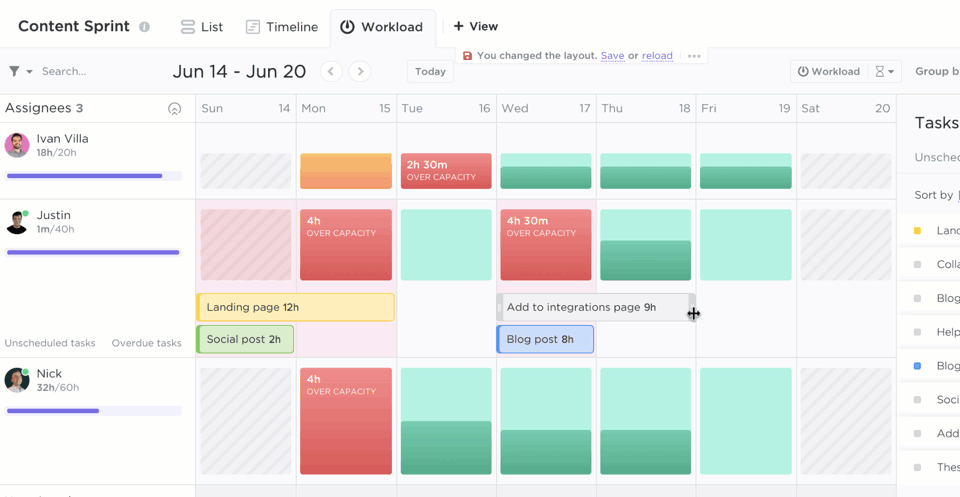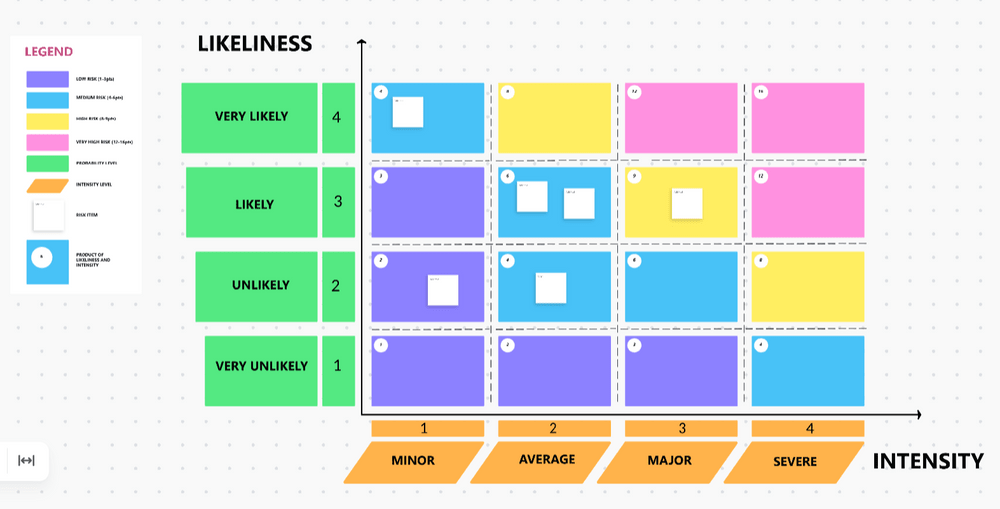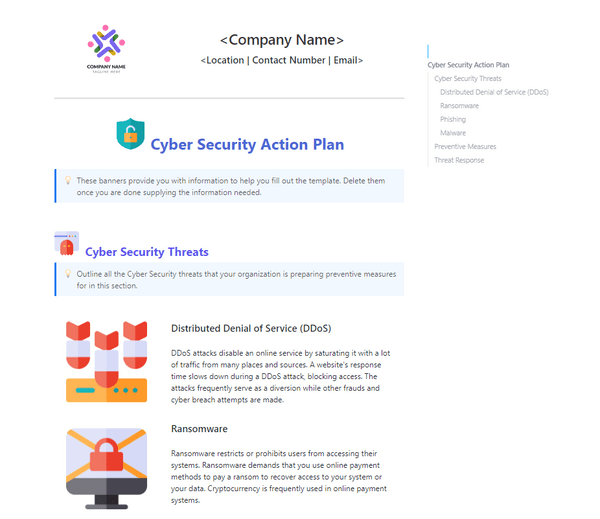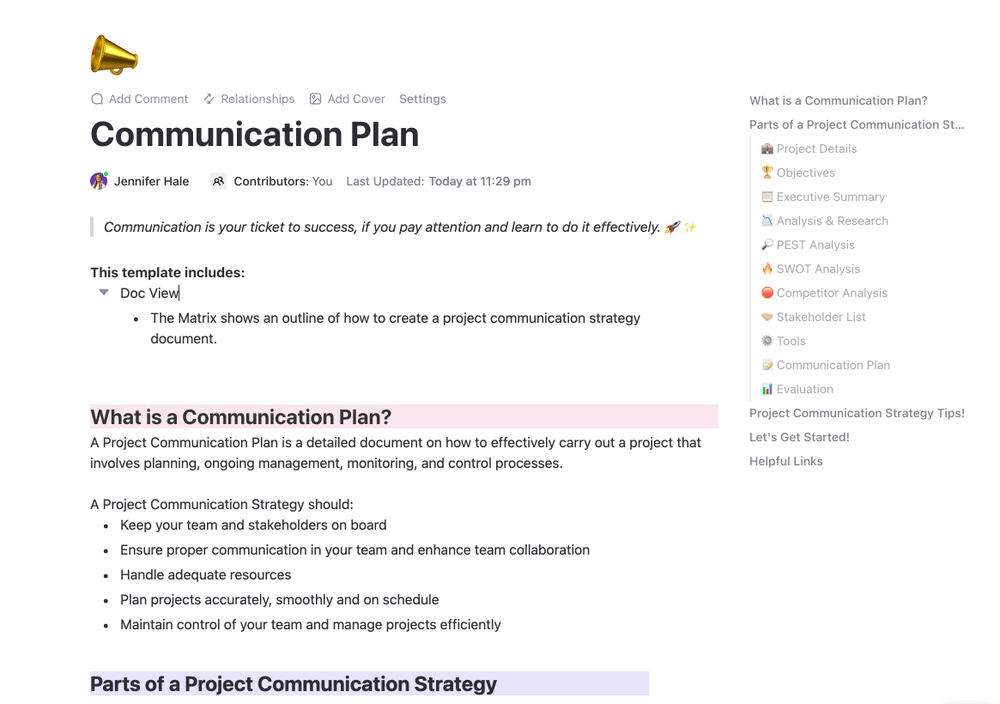في مجال الأعمال، الثابت الوحيد هو عدم الاتساق.
سواء كانت كوارث طبيعية، أو انتهاكات للأمن السيبراني، أو اضطرابات في سلسلة التوريد، يمكن أن تقع أحداث غير متوقعة في أي وقت. وهذا ليس مجرد حديث ينذر بالخطر - فمن الواضح أن مخاطر الأعمال يمكن أن تظهر في أي مكان، ولكن يمكنك تجنب الكثير من خلال خطة احتياطية عامة.
ولهذا السبب فإن تطوير خطة طوارئ ضرورية لكل مؤسسة. ومع ذلك، فإن الأمر يتطلب معرفة ما يجب تضمينه، وكيفية وضع تدابير استباقية، وكيفية جعل هذه الخطة جاهزة في أي وقت حتى تحافظ على سير العمليات بشكل طبيعي.
وهنا يأتي دور هذا الدليل. 💪
دعنا نتعرف على عملية التخطيط للطوارئ لمساعدة فريقك على تجاوز التحديات غير المتوقعة بثقة. فيما يلي كيفية البدء في حماية أعمالك من التحديات غير المتوقعة.
ما هي خطة الطوارئ؟
خطة الطوارئ هي استراتيجية استباقية مصممة لمساعدة الشركات على الاستعداد للمخاطر والاضطرابات المحتملة. وهي تحدد الخطوات اللازمة لتقليل الأضرار المحتملة، وضمان استمرار عملياتك التجارية، وأن تتمكن المؤسسة من التعافي من أكبر المخاطر أو المواقف السلبية غير المتوقعة.
تفهم خطط طوارئ الأعمال المخاطر الرئيسية التي يمكن أن تعرقل مشروعاً بأكمله أو استمرارية العمل. عادةً ما يعتمد التخطيط للطوارئ على تحليل تأثير الأعمال من أجل تحديد أكبر المخاطر والنكسات المحتملة . يتيح ذلك للشركات إنشاء خيار احتياطي استباقي من الخطة الأصلية.
فوائد وجود خطة طوارئ ## فوائد وجود خطة طوارئ
من الكوارث المرتبطة بالطقس إلى خروقات البيانات، يُحدث التخطيط للطوارئ فرقاً كبيراً عند حدوث ما هو غير متوقع. هناك الكثير من الأسباب لإنشاء خطط طوارئ - لأسباب واضحة وغير واضحة.
إليك بعض فوائد التخطيط للطوارئ التي قد لا تدركها:
1. يبقي الأضرار والخسائر تحت السيطرة
إن وجود خطة طوارئ قوية يعني أنك على استعداد للتعامل مع أي شيء تواجهه الحياة في عملك. والجزء الأفضل؟ أنه يقلل من تأثير هذه المفاجآت على عملك. على سبيل المثال، يمكن أن تكون إدارة المخاطر المالية أو التشغيلية أو إدارة المخاطر المتعلقة بالسمعة لتقليل الأضرار والخسائر إلى الحد الأدنى.
مع وجود خطط طوارئ مفصلة في مكانها الصحيح، فإنك تهيئ نفسك للبقاء قوياً مهما كانت الظروف.
2. يسمح للشركات بالحفاظ على العمل كالمعتاد - حتى عندما لا يكون كذلك
تعمل الكثير من الشركات على نموذج أن كل شيء يسير بشكل مثالي - باستثناء بعض العثرات هنا وهناك. ولكن كيف تخطط المؤسسات لمواجهة الكوارث غير المتوقعة من الطقس أو حالات الطوارئ الأخرى التي يمكن أن تعطل سلسلة التوريد الخاصة بك؟
يمكن أن تصاب بالذعر - أو تشعر ببعض الارتياح مع العلم أن خطط الطوارئ التي وضعتها تتضمن خطة احتياطية مفصلة للحفاظ على استمرارية العمل - حتى يظل كل شيء يعمل بسلاسة. يسمح لك التخطيط للطوارئ بالتكيف مع كل ما يعترض طريقك والاستمرار في خدمة عملائك بأقل قدر من الانقطاع.
هذا ما تسميه الآن الاستقرار.
3. يساعد الشركات على استعادة عافيتها في أسرع وقت
لنكن واقعيين - كلما أسرعت في التعافي من حدث غير متوقع، كان ذلك أفضل. تساعدك عملية التخطيط للطوارئ على تحديد ما تحتاج إلى القيام به للعودة إلى المسار الصحيح في أسرع وقت ممكن.
والنتيجة؟ أنت توفير الوقت والموارد وتجنب أي متاعب إضافية قد تنجم عن تعطل العمل لفترة طويلة - بما في ذلك فقدان قاعدة العملاء التي عملت بجد لتنميتها.
4. يجعل من الأسهل كسب العملاء والاحتفاظ بهم
إليك هذا الأمر - يريد عملاؤك وأصحاب المصلحة الرئيسيين أن يعرفوا أنك تدعمهم. عندما يكون لديك خطة طوارئ تجارية جاهزة، فإنك تُظهر للعملاء أنك جاد في الحفاظ على خدمة وموثوقية من الدرجة الأولى.
إنها طريقة متينة لبناء الثقة، وتعزيز ولاء العملاء، وإظهار أن عملك يعمل بغض النظر عن الموقف - حتى تتمكن من التركيز فقط على ما هو أكثر أهمية.
كيفية إنشاء خطة طوارئ للأعمال: دليل خطوة بخطوة
هل أنت مستعد لوضع خطط الطوارئ الخاصة بك؟ اتبع هذه الخطوات السبع لضمان استعداد شركتك للأمور غير المتوقعة.
1. قم بتجميع فريق تخطيط للطوارئ
اجمع مجموعة متنوعة من الموظفين وأصحاب المصلحة الذين يفهمون أعمالك ويقدمون رؤى قيمة حول المخاطر والحلول المحتملة.
يجب أن يضم هذا الفريق ممثلين من مختلف الأقسام ومستويات المسؤولية، مما يضمن وجود منظور شامل. تذكّر أن الفريق المتنوع يكتشف النقاط العمياء المحتملة بشكل أفضل ويجلب أفكاراً إبداعية لحل المشاكل.
2. لا تدخر جهدًا
حدد الاضطرابات المحتملة - الكوارث الطبيعية أو انتهاكات الأمن السيبراني أو مشاكل الموظفين أو غيرها من المخاطر - وقيّم تأثيرها المحتمل على عملك. تعمق في عملياتك وفكر في التهديدات الداخلية والخارجية على حد سواء.
استشر فريقك والخبراء الخارجيين إذا لزم الأمر، وأنشئ قائمة شاملة بالمخاطر التي يمكن أن تؤثر على استمرارية عملك.
3. تعامل مع السمكة الأكبر أولاً
رتب المخاطر المحددة وفقًا لعواقبها المحتملة واحتمالية حدوثها بالفعل. ركز على الأحداث ذات التأثير الكبير والاحتمالية العالية لوقوعها في خطة الطوارئ الخاصة بك.
ستساعدك عملية تحديد الأولويات هذه على تخصيص الموارد بفعالية والتأكد من أنك تتعامل مع التهديدات الأكثر أهمية أولاً. تذكر أنه من الضروري تحقيق التوازن بين التصدي للتهديدات الفورية والاستعداد للمخاطر طويلة المدى.

استخدم طريقة عرض عبء العمل في ClickUp لمعرفة من هو متقدم أو متأخر وسحب المهام وإفلاتها بسهولة لإعادة تخصيص الموارد
4. خطط للفعل - وليس لرد الفعل
بالنسبة لكل خطر، ضع خطة مفصلة تحدد الخطوات التي ستتخذها شركتك للتخفيف من التهديد وتقليل تأثيره. يجب أن تكون استراتيجيات الاستجابة هذه واضحة وقابلة للتنفيذ ومصممة خصيصًا من أجل الخطر المحدد المطروح .

استخدم طرق عرض المجلس أو القائمة لوضع خطة لتجنب الأزمات والحفاظ على استقرار العمليات التجارية
والأفضل من ذلك، لا تبدأ من الصفر. يوفر ClickUp قالب طوارئ جاهزًا لك يمكنك ملؤه ومشاركته مع فريقك بأكمله. بينما تواصل وضع خطة الطوارئ الخاصة بك، ضع في اعتبارك الحلول قصيرة الأجل وطويلة الأجل، وتأكد من أن خطتك مرنة بما يكفي للتكيف مع الظروف المتغيرة. كلما كانت أكثر تحديدًا خطط العمل الخاصة بك كلما كان فريقك مستعداً بشكل أفضل.
5. إنشاء التواصل وإبقاء الخطوط مفتوحة
حدد كيفية مشاركة المعلومات ووضع مبادئ توجيهية لتنسيق جهود الاستجابة بين أعضاء الفريق وأصحاب المصلحة. قد يتضمن ذلك إنشاء قنوات اتصال مخصصة، أو تعيين نقاط اتصال، أو تطبيق نظام إبلاغ مركزي.
وقد يكون من المفيد إضافة ذلك إلى عملية تأهيل الموظفين. الهدف هو ضمان أن يكون جميع المشاركين في تنفيذ خطة الطوارئ على نفس الصفحة.
6. تدريب الموظفين وتوعيتهم
قم بتثقيف موظفيك حول المخاطر التي حددتها وتأكد من أنهم على دراية بخطة الطوارئ. قم بإجراء دورات تدريبية وتدريبات منتظمة لإبقاء الجميع على أهبة الاستعداد.
تأكد من فهم فريقك لدورهم في الخطة وتجهيزهم بالمهارات والمعرفة اللازمة لتنفيذ مسؤولياتهم. من سيقوم بماذا؟ ما هي التوقعات؟
إن الفريق المطلع والمدرّب جيداً هو أقوى ما لديك في مواجهة التحديات غير المتوقعة.
7. مراجعة خطة الطوارئ وتحديثها بانتظام: البقاء في الطليعة
كن استباقيًا من خلال المراجعة الدورية لخطة الطوارئ الخاصة بك وإجراء التحديثات اللازمة بناءً على التغييرات في بيئة عملك أو المخاطر الجديدة أو الدروس المستفادة من الحوادث السابقة .
ضع جدولًا زمنيًا لعمليات التحقق الروتينية لإعادة تقييم المخاطر المحتملة وتقييم فعالية استراتيجيات الاستجابة الخاصة بك وإجراء أي تعديلات ضرورية. إن خطة الطوارئ هي وثيقة حية - حافظ على تحديثها وملاءمتها للبقاء على استعداد لأي شيء يأتي في طريقك.
عناصر خطة الطوارئ ## عناصر خطة الطوارئ
يتطلب إنشاء خطط طوارئ شاملة عدة عناصر حاسمة - فكر فيها على أنها اللبنات الأساسية لأساس متين من التأهب. دعنا نستكشف كل عنصر من هذه العناصر بالتفصيل:
تقييم المخاطر وتحديدها: تعرف على التهديدات التي تواجهك
أولاً، تحتاج أولاً إلى التعمق في عملياتك التجارية وتحديد التهديدات المحتملة التي يمكن أن تعطل عملياتك.
ضع في اعتبارك كل شيء بدءًا من الكوارث الطبيعية والهجمات الإلكترونية إلى التغييرات في الموظفين والمشكلات المتعلقة بسلاسل التوريد. بمجرد أن تقوم بتجميع قائمة بالمخاطر، قم بتقييم تأثيرها المحتمل على عملك لتحديد مدى خطورة كل تهديد.
تدور إدارة المخاطر حول معرفة احتمالية حدوث أي شيء وكل شيء يمكن أن يوقف عملياتك مؤقتاً. إليك بعض الأسباب الشائعة لـ وضع خطط طوارئ :
- التعافي من الكوارث الطبيعية (مثل الفيضانات والزلازل والأعاصير والأعاصير)
- الأوبئة أو الأزمات الصحية واسعة النطاق
- تعطل سلسلة التوريد أو نقصها
- انتهاكات الأمن السيبراني أو سرقة البيانات
- الأعطال التكنولوجية أو انقطاع النظام
- التغييرات التنظيمية أو المسائل القانونية
- الانكماش الاقتصادي أو تقلبات السوق
- إجراءات المنافسين أو تحولات الصناعة
- حوادث مكان العمل أوحوادث السلامة
- أعمال الإرهاب أو الاضطرابات المدنية
- الأضرار التي تلحق بالمرافق أو المعدات (مثل الحرائق والتخريب)
- نزاعات الملكية الفكرية أو السرقة
- خسارة كبار العملاء أو العقود
- الأحداث الضارة بالسمعة (مثل سحب المنتجات، وأزمات العلاقات العامة)
- المخاطر أو الحوادث البيئية (مثل الانسكابات الكيميائية وحوادث التلوث)

قم بإنشاء عملية منهجية لتحديد المخاطر والمخاطر وتقييمها والتحكم فيها باستخدام قالب السبورة البيضاء لتقييم المخاطر من ClickUp
جرّب قالب لوحة بيضاء لتقييم المخاطر ClickUp للتخطيط بشكل تعاوني حول جميع المشكلات المحتملة التي قد تضر بعملياتك. تسمح اللوحة البيضاء المرئية للجميع بالمشاركة ورؤية المخاطر والاستراتيجيات اللازمة لمعالجتها بوضوح في مساحة واحدة. الآن، ستبدو خطة الطوارئ الخاصة بك أفضل من أي وقت مضى.
تحديد أولويات المخاطر: التركيز على ما هو أكثر أهمية
ليست كل المخاطر متساوية. ولتحقيق أقصى استفادة من جهودك في التخطيط للطوارئ، حدد أولويات المخاطر بناءً على احتمالية وقوعها وكذلك على عواقبها.
ركز على معالجة الأحداث ذات التأثير الكبير والاحتمالية العالية أولاً، ثم انتقل إلى أسفل القائمة للتأكد من أنك تتعامل مع التهديدات الأكثر أهمية بشكل مباشر للحصول على خطة بديلة قوية.

قم بترتيب أهمية أصحاب المصلحة الخارجيين والداخليين على لوحة معلومات ClickUp
الـ قالب مصفوفة أولويات ClickUp يساعد في تحديد أولويات المهام والمشاريع بناءً على تأثيرها على المستخدمين والجهد المطلوب لتنفيذها. إنها أداة مفيدة لتقييم سير العمل التشغيلي والتحسينات، مع سهولة تحديد الأولويات باستخدام مصفوفة 3×3.
استراتيجيات الاستجابة وخطط العمل: كن استباقيًا - وليس تفاعليًا
بالنسبة لكل خطر تم تحديده، ضع خطة واضحة وقابلة للتنفيذ تحدد الخطوات التي ستتخذها شركتك لتقليل التهديد وتأثيره.
تذكر أنه من الضروري أن تكون استباقيًا وليس تفاعليًا - فوجود استراتيجيات استجابة محددة جيدًا سيساعدك على التصرف بسرعة وحسم عند مواجهة تحديات غير متوقعة.

استخدام قالب خطة عمل الأمن السيبراني من ClickUp لإنشاء خطة تنفيذ منظمة ومفصلة للأمن السيبراني
بالنسبة لفرق تكنولوجيا المعلومات، يجب أن تتضمن خطط الطوارئ كيفية التعامل مع أي تهديدات للأمن السيبراني. إن قالب خطة عمل الأمن السيبراني ClickUp للأمن السيبراني يساعد أقسام تكنولوجيا المعلومات على إضافة تفاصيل مهمة إلى خطة الطوارئ.
التواصل والتنسيق: أبقِ الجميع على اطلاع
إليك ملاحظة مهمة يجب وضعها في الاعتبار: لا تكون خطة الطوارئ فعالة إلا إذا كان جميع المعنيين على علم بها ويفهمون دورهم.
حدد كيفية مشاركة المعلومات أثناء الطوارئ، وضع بروتوكولات لتنسيق الجهود بين أعضاء الفريق وأصحاب المصلحة. على سبيل المثال, برنامج الموارد البشرية مع التواصل الواضح وميزات التنسيق السلس يمكن أن يكون أمرًا حيويًا للاستجابة الناجحة لأي أزمة.

استخدم أدوات التنسيق العديدة في ClickUp لإنشاء مرئيات الخطة وتنظيم المعلومات بسرعة
إذا كنت بحاجة إلى مساعدة في إعداد عملية التواصل الداخلي أو الخارجي أثناء الأزمات، فإن نموذج خطة التواصل ClickUp أمر لا بد منه. هذا النموذج خطوات بسيطة لبناء خطة تواصل فعالة مع أقسام قابلة للتخصيص بسهولة في جميع أنحاء المستند حتى يتسنى لك وضع خطة طوارئ تكون خطة الطوارئ الخاصة بك شاملة قدر الإمكان.
التدريب والتوعية: تمكين فريقك
قم بتثقيف موظفيك حول المخاطر المحتملة وخطة الطوارئ نفسها.
قم بإجراء دورات تدريبية وتدريبات منتظمة للتأكد من أن الجميع على دراية بمسؤولياتهم وعلى استعداد للتصرف عندما يحين الوقت. فالفريق المطلع والمدرب جيداً هو أقوى ما لديك عند مواجهة التحديات غير المتوقعة.

هل أنت مستعد لإنشاء عمليات في شركتك؟ يسلط قالب العمليات والإجراءات هذا الضوء على المهام التي تحتاج إلى القيام بها لإنشاء مستند عملية حي! يمكنك أيضًا استخدام اللوحة البيضاء لمعرفة كيف ستتدفق العمليات إلى بعضها البعض
احصل على السبق مع قالب إجراءات وعمليات شركة ClickUp لتوثيق وتنظيم دليل التخطيط للطوارئ في المؤسسة بسهولة. سيمنحك هذا القالب عظام خطة قوية للحصول على موافقة الموظفين ومعرفة ما يجب القيام به على وجه التحديد إذا تغيرت الظروف.
خطة الصيانة والتحديثات: حافظ على حداثتها وملاءمتها
أخيرًا، لا تدع خطة الطوارئ الخاصة بك تتراكم عليها الأتربة. قم بمراجعتها ومراجعتها بانتظام ومراجعتها حسب الحاجة للتأكد من أنها تظل محدثة ومتوافقة مع بيئة عملك الحالية.
ضع جدولاً زمنياً لإجراء عمليات مراجعة دورية لتقييم المخاطر المحتملة وتقييم فعالية استراتيجيات الاستجابة الخاصة بك وإجراء أي تعديلات ضرورية. إن خطة الطوارئ هي وثيقة حية - حافظ على تحديثها وملاءمتها لتبقى مستعدًا لأي شيء يأتي في طريقك. 🚀

تأكد من سلاسة العمليات التجارية مع وجود خطة استمرارية استباقية بمساعدة هذا النموذج المفصل
لا تجعل التخطيط أكثر صعوبة مما هو عليه - استخدم نموذج قالب خطة استمرارية الأعمال ClickUp واطمئن إلى أنك قمت بتضمين كل شيء. أضف خطط إعادة التقييم للعودة وتعديل خطط الطوارئ بناءً على التهديدات أو المخاطر الجديدة التي قد تواجهها ومراجعتها كل عام.
أمثلة على خطة الطوارئ
استجابة تويوتا السريعة لكارثة تسونامي 2011
في عام 2011 ضرب اليابان زلزال مدمر وتسونامي مدمران، مما تسبب في دمار واسع النطاق وأثر بشكل كبير على الشركات في جميع أنحاء البلاد. ولم تكن تويوتا، الشركة الرائدة عالمياً في صناعة السيارات، استثناءً من ذلك. عانت سلاسل التوريد من اضطرابات هائلة بسبب تضرر البنية التحتية وتأثر الموردين.
ومع ذلك، لعبت خطة طوارئ أعمال تويوتا دوراً حاسماً في الحد من تأثير الكارثة على الشركة. فقد اكتشفت الشركة بالفعل المخاطر المحتملة المرتبطة بالكوارث الطبيعية ووضعت تدابير للتصدي لها من خلال خطة احتياطية محكمة.
وقد لعب تخطيط استمرارية الأعمال في الشركة دوراً كبيراً في تعافي الشركة بسرعة. وفيما يلي بعض من أفضل الأمثلة على خطتهم:
تحويل الإنتاج إلى مواقع بديلة
تضمنت "الخطة البديلة" لتويوتا عملية استجابة للطوارئ لتحويل الإنتاج إلى منشآت أخرى. عندما ضرب التسونامي، سارعت تويوتا إلى نقل بعض عمليات التصنيع إلى مصانع غير متضررة داخل اليابان وخارجها.
وساعدت هذه الأنواع من التدابير الاستباقية في الحفاظ على مستويات الإنتاج وضمنت استمرار الشركة في تلبية طلبات العملاء خلال الأزمة.
الاستفادة من الموردين البديلين
أثرت الأزمة أيضاً على العديد من الموردين الذين اعتمدت عليهم تويوتا في الحصول على قطع الغيار والمواد. ولتقليل التأثير على سلاسل التوريد، استفادت الشركة من شبكتها الواسعة من الموردين العالميين، ولجأت إلى مصادر بديلة لشراء المكونات الضرورية.
سمحت استراتيجية التنويع هذه لشركة تويوتا بالحفاظ على جداول إنتاجها وتقليل التأخر في تسليم سيارات العملاء.
تنفيذ جهود التعافي
في أعقاب الأزمة، حشدت تويوتا مواردها بسرعة لدعم جهود التعافي. وعملت الشركة عن كثب مع الموردين المتضررين لمساعدتهم على استعادة عملياتهم، وقدمت المساعدة المالية، وشاركت خبراتها في مجال التعافي من الكوارث.
من خلال استباق "ماذا لو"، أظهرت تويوتا قوة التخطيط الفعال للطوارئ في حالة وقوع كارثة كبرى.
اجعل فريقك مستعداً بخطة طوارئ
تذكر أن الهجوم الجيد هو أفضل دفاع. لهذا السبب يدفعك التخطيط للطوارئ إلى أن تكون استباقيًا في إدارة المخاطر . من خلال تحديد التهديدات المحتملة ومعالجتها قبل أن تتصاعد - والحفاظ على تحديث خطتك - ستكون مستعدًا دائمًا للاستجابة بفعالية. الأمر أشبه بوجود سلاح سري في جيبك الخلفي.
سواء كنت تستخدم أحد قوالب ClickUp أو إنشاء خطة طوارئ من الصفر، فإن خطة الطوارئ هي أكثر بكثير من مجرد الاستعداد لما هو غير متوقع. فالأمر يتعلق بتقليل الأضرار، وضمان استمرارية الأعمال، والتعافي السريع، وبناء الثقة، والاستباقية.
استخدم ClickUp كمساحة مركزية للتواصل والتخطيط وتنظيم المستندات الأساسية. بالإضافة إلى ذلك، يمكنك الاعتماد على اللوحات البيضاء لتنظيم خطط الاستجابة بشكل تعاوني.
عندما تجمع كل ذلك مع ClickUp، ستحصل على وصفة لمؤسسة مرنة ومرنة وناجحة تواجه أي شيء تواجهه في الحياة. امنح ClickUp جرب اليوم مجانًا !

